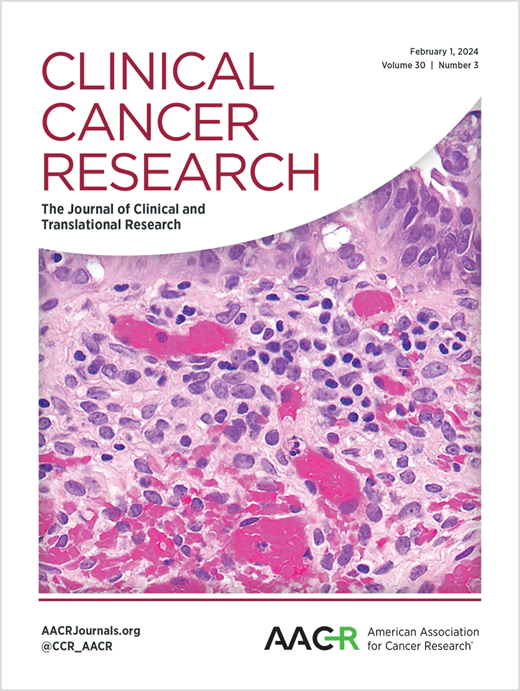Spatial heterogeneity, stromal phenotypes, and therapeutic vulnerabilities in colorectal cancer peritoneal metastasis
IF 10
1区 医学
Q1 ONCOLOGY
引用次数: 0
Abstract
Purpose: Peritoneal metastases (PM) in colorectal cancer (CRC) portend a poor prognosis. We sought to elucidate molecular features differentiating primary tumors (PTs) from PMs and actionable targets facilitating transcoelomic dissemination and progression. Experimental Design: We performed multi-omic profiling of 227 samples from 136 patients, including 56 primary tumor (PT) and 120 synchronous PMs comprising 34 matched PT-PM pairs. Whole exome, and bulk RNA-seq analysis was conducted to identify underlying genomic aberrations and transcriptomic differences between primary and peritoneal lesions. We spatially characterized the microenvironment of tumor-stroma compartments and studied the roles of stromal phenotypes in promulgating tumorigenesis. Results: Whole exome sequencing found genomic alterations and clonality patterns between PTs and PMs remain broadly similar. Transcriptomic profiles however, suggest a transition as tumors reach the peritoneum towards a more mesenchymal tumor profile and fibrotic tumor microenvironment. Applying spatial profiling, we identify a fibro-collagenous and immune-infiltrated stromal phenotype (stromal cluster [SC] 2) characterized by increased cancer-associated fibroblasts, memory B cells, M2 macrophages and T-cell exhaustion. These findings were orthogonally validated by multiplex immunohistochemistry. Patients with SC2 stroma had poorer survival and were characterized by high SERPINE-1 (PAI-1) expression. PM in patients with SC2 stroma were associated with enriched oncogenic pathways such as TGF-β. PAI-1 inhibition of CRC PM cell-lines with a novel biologic demonstrated reduced IL2-STAT5 and TGF-β pathways and cell death. Conclusions: Our findings unveil distinctive and actionable molecular signatures, offering deeper insights into the intricate crosstalk between tumor cells and stromal microenvironments enabling PM in CRC.结直肠癌腹膜转移的空间异质性、基质表型和治疗脆弱性
目的:结直肠癌腹膜转移(PM)预后较差。我们试图阐明区分原发性肿瘤(PTs)和原发性肿瘤(pm)的分子特征以及促进跨体腔传播和进展的可操作靶点。实验设计:我们对来自136例患者的227个样本进行了多组学分析,其中包括56例原发性肿瘤(PT)和120例同步pm,包括34对匹配的PT- pm对。进行了全外显子组和大量RNA-seq分析,以确定原发性和腹膜病变之间潜在的基因组畸变和转录组差异。我们对肿瘤间质室的微环境进行了空间表征,并研究了间质表型在促进肿瘤发生中的作用。结果:全外显子组测序发现PTs和pm之间的基因组改变和克隆模式大致相似。然而,转录组学分析表明,当肿瘤到达腹膜时,肿瘤向间质肿瘤和纤维化肿瘤微环境转变。通过空间分析,我们发现了一种纤维胶原和免疫浸润的基质表型(基质簇[SC] 2),其特征是癌症相关成纤维细胞、记忆B细胞、M2巨噬细胞和t细胞衰竭增加。这些发现经多重免疫组织化学正交验证。SC2间质患者的生存率较低,并且以高SERPINE-1 (PAI-1)表达为特征。SC2间质患者的PM与TGF-β等富集的致癌途径相关。PAI-1对结直肠癌PM细胞系的抑制表明,il - 2- stat5和TGF-β通路减少,细胞死亡。结论:我们的研究结果揭示了独特的、可操作的分子特征,为肿瘤细胞和基质微环境之间复杂的串扰提供了更深入的见解,从而实现了CRC中的PM。
本文章由计算机程序翻译,如有差异,请以英文原文为准。
求助全文
约1分钟内获得全文
求助全文
来源期刊

Clinical Cancer Research
医学-肿瘤学
CiteScore
20.10
自引率
1.70%
发文量
1207
审稿时长
2.1 months
期刊介绍:
Clinical Cancer Research is a journal focusing on groundbreaking research in cancer, specifically in the areas where the laboratory and the clinic intersect. Our primary interest lies in clinical trials that investigate novel treatments, accompanied by research on pharmacology, molecular alterations, and biomarkers that can predict response or resistance to these treatments. Furthermore, we prioritize laboratory and animal studies that explore new drugs and targeted agents with the potential to advance to clinical trials. We also encourage research on targetable mechanisms of cancer development, progression, and metastasis.
 求助内容:
求助内容: 应助结果提醒方式:
应助结果提醒方式:


